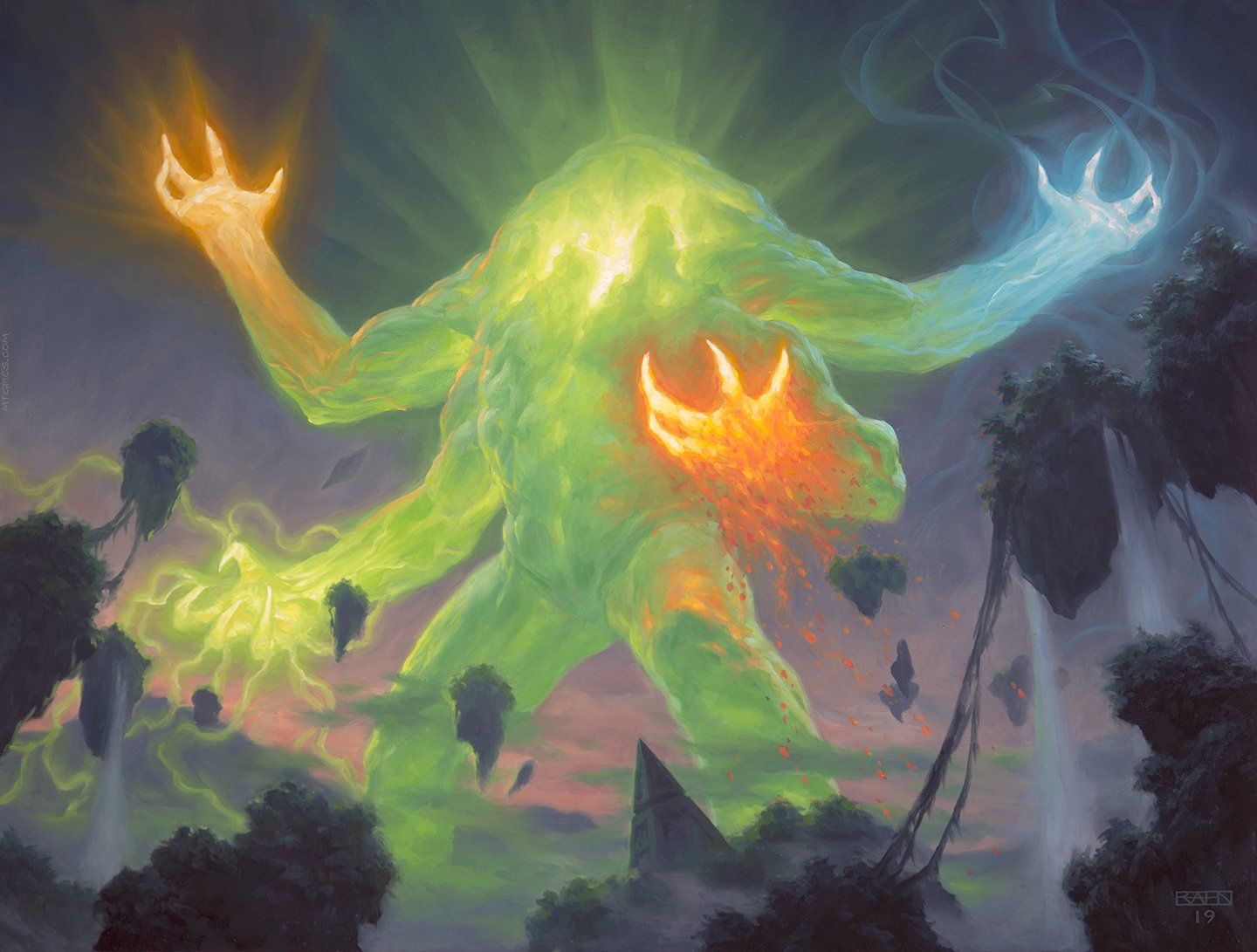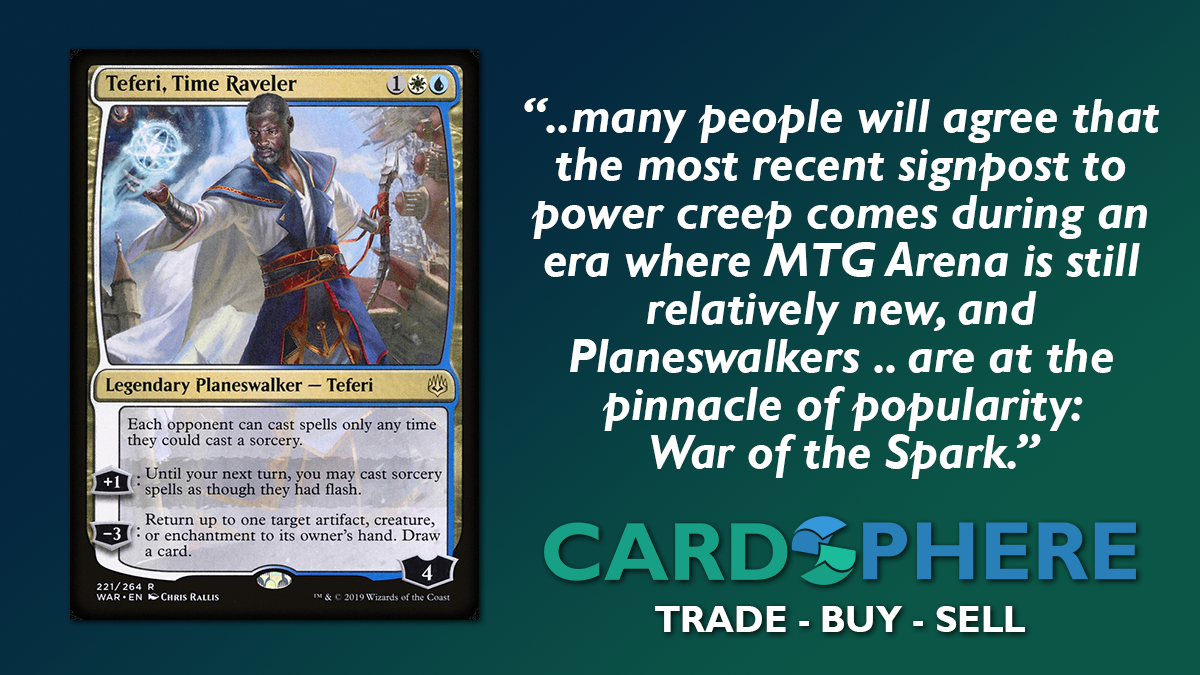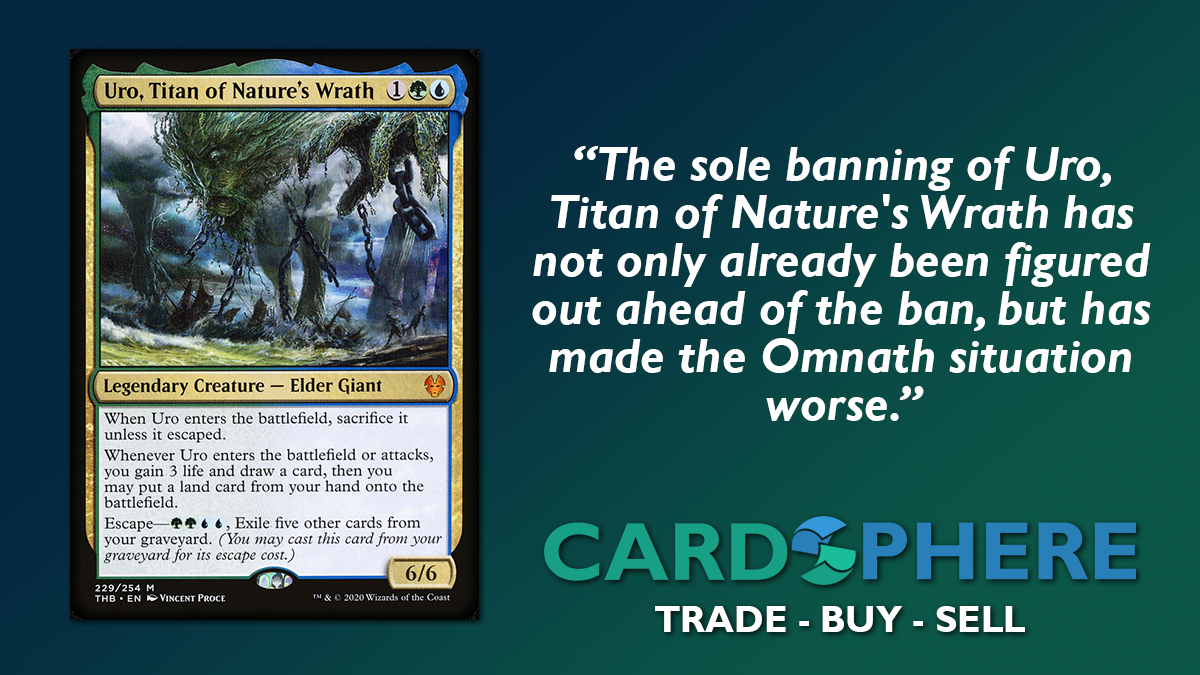The Banlist: An Essential Step to Combat Power Creep

It is 2004. Invasion of Chaos (IOC) has just released for the Yu-Gi-Oh TCG. At the time, Invasion of Chaos was the most powerful set ever created. To remain competitive, players needed powerful rares and secret rares in order to keep up with the massive amount of removal and resources that came with cards like Chaos Emperor Dragon: Envoy of the End. If a player did not fully invest in the new meta, then they were completely left out of the competition. This was how many Yu-Gi-Oh players were introduced to power creep; each set outstripped the power level of the set prior, forcing players to empty their wallets or abandon competitive play.
Play overpowered cards or perish in competitive play should sound familiar to Magic players. There are many sets throughout Magic's history people can point to and say "This is the set where power creep started, and this is the set where power creep ramped up." While that conversation is fascinating and worth visiting, it could make for an entirely different article.
However, many people will agree that the most recent signpost to power creep comes during an era where MtG Arena is still relatively new, and Planeswalkers and their stories are at the pinnacle of popularity: War of the Spark. While the argument can be made that there are shadows of the recent, intense power creep beginning with Kaladesh block's Smuggler's Copter or Walking Ballista , and Dominaria's Teferi, Hero of Dominaria , these pale in comparison to format-warping behemoths Teferi, Time Raveler, Fires of Invention, Wilderness Reclamation, Field of the Dead, and now Uro, Titan of Nature's Wrath.

Since power creep keeps these powerful and format-warping cards getting printed, there is only one remedy to save formats: the ban list. Banning cards is not a sign of weakness. On the contrary, banning cards communicates to competitors and customers of a game that research and development cares enough about a game to create effective modifications to make the format more enjoyable for competitors and casual players alike.
We look to the past for guidance on how not to make the same mistakes. Unfortunately for Yu-Gi-Oh's Research and Development in 2004, they did not have access to the volume and scope of information that 2020 WotC's Research and Development does. All the same, in October 2004 Yu-Gi-Oh TCG decided it was time for a change as gameplay had become too consistent; almost everyone was using the same deck. Tournament organizers and card stores compaRed statistics of what was selling and what was played and determined that the format had become broken. As a result, the first ever "Forbidden" list was introduced for Yu-Gi-Oh. The idea was to prevent players from playing the same 1-2 decks, and encourage this diversity without penalizing competitive play for not only using the most powerful cards. The aforementioned and infamous "Chaos Emperor Dragon- Envoy of the End" which destroyed the battlefield and drained both players hands, was finally banned along with another broken card that combos with it from a previous set - Yata Garasu.
The first Yu-Gi-Oh TCG forbidden list included 13 cards.
How to Fix Standard
WotC's Play Design team has had ample opportunity to learn from past bannings, but based on cards recently printed it appears that some of these lessons may have been lost in time. We're not talking about the iconically broken Jace, The Mind Sculptor, but reprints of very familiar spells such as Cultivate, Lotus Cobra, and Solemn Simulacrum, which may have not have been problematic on their own, but foreshadowed greater problems to come. Competitors already knew that Lotus Cobra was broken when combined with fetches and Harrow during the original Zendikar, but even with no fetchable duals in the current Standard, colors are still quite accessible with Fabled Passage, Triomes, Temples, and the new Modal Double-Faced Lands still in the format. The combination of abundant ramp, a variety of multi-color lands, and costly but powerful spells including Ugin, The Spirit Dragon, Escape to the Wilds, Lucky Clover, and Genesis Ultimatum is a problem that Research and Development should have seen coming.

The concept of ramping and mana duplication has been around for quite a long time, but combining that with the extreme amount of power creep we have seen in the past 2-3 years has erupted into the disaster that is 2020/2021 Standard. When we see WotC ban Uro, Titan of Nature's Wrath but not Omnath, Locus of Creation or Lucky Clover, we understand the current focus to be on banning the symptoms, and ignoring power creep as the disease. This is perhaps best evidenced in the fact that Uro was not banned along with Growth Spiral.
Instead, we'd like to suggest the following steps to fix Standard.
Admit Mistakes
Considering how far in advance cards are designed, largely with limited foreknowledge of what the competitive meta will be, Magic players understand the challenges Play Design face. But considering the amount of feedback that the hive mind provides, it's reasonable to think mistakes can be admitted sooner than what we've seen. Of all the recent bans, none were really surprises, right?
Go Wide
Instead of looking to ban the fewest cards possible, WotC should evaluate a wider set of potentially problematic cards, finding at least three cards to propose with each banlist announcement. Look at more data, more decklists, more solutions. Decision making can be solidified closer to banlist announcements to pare the list down if the data show this would be safe, while keeping options open and decision makers well informed throughout the process.
Bring it to the People
Another solution we can see working would be for WotC to reach out to the MPL, Rivals, prominent content creators, and analysts, and receive constructive feedback in good faith from trusted community members. With the pillars of the community in competitive play providing feedback, effective communication can be established and the banlist can be used - and even temporarily embraced during this era of extreme power creep - as a tool to fix formats rather than assigning a scarlet letter to them.
This would still allow for design space exploration, taking chances on some innovative concepts, a la companion mechanic, but knowing that there would be a reliable safety valve if things get out of hand. This would be, we believe, a more accepted alternative to repetitive sets on the multicolor/artifact/kindred/graveyard cycle of themes. Accidents happen, fix it, sever the emotional attachment with certain card designs and concepts not working, and move on. Ideally, these decisions should be made as early as possible as this complicates the paper market (yes, paper MtG is still essential, valued, and loved even in 2020), but until power creep is slowed, banlists will need to become a regular part of MtG sanctioned play to ensure a healthy format containing 3-4 meta decks.

The consequences of either attempting to slow power creep, or implementing a bit of a longer banlist could be disastrous - especially for those who like to play constructed, but not vast and deep eternal formats such as legacy, modern, pioneer, and possibly historic. Competitive MtG players will always want to play the deck that yields the greatest value possible. Who wouldn't want to draw cards and control the field while simultaneously building up a board presence that cannot be contested? The sole banning of Uro, Titan of Nature's Wrath has not only already been figured out ahead of the ban, but has made the Omnath situation worse.
Post-Ban Decks to Watch
Last weekend, Kentaro Yamamoto combined the value of Omnath, Locus of Creation with Lucky Clover, and produced a devastating engine of value that is going to be difficult for any MtG competitor to turn down given its vast value.
4 Beanstalk Giant // Fertile Footsteps
4 Bonecrusher Giant // Stomp
4 Branchloft Pathway // Boulderloft Pathway
2 Brazen Borrower // Petty Theft
2 Cragcrown Pathway // Timbercrown Pathway
4 Edgewall Innkeeper
3 Escape to the Wilds
4 Fabled Passage
4 Fae of Wishes // Granted
4 Forest
2 Giant Killer // Chop Down
4 Island
2 Ketria Triome
2 Lovestruck Beast // Heart's Desire
4 Lucky Clover
2 Mountain
4 Omnath, Locus of Creation
1 Plains
2 Raugrin Triome
1 Riverglide Pathway // Lavaglide Pathway
1 Shatterskull Smashing // Shatterskull, the Hammer Pass
1 Elspeth Conquers Death
1 Embereth Shieldbreaker // Battle Display
1 Escape to the Wilds
1 Essence Scatter
1 Kazuul's Fury // Kazuul's Cliffs
3 Mystical Dispute
1 Negate
1 Primal Might
1 Redcap Melee
1 Soul-Guide Lantern
1 Storm's Wrath
1 Thundering Rebuke
1 Ugin, the Spirit DragonTemur Clover and 4C Omnath have essentially combined forces in this deck to create Four-Color Omnath Adventures. If Lucky Clover hits the board in the first four turns, it will be very difficult to come back as the game ramps, destroys, bounces, and wishboards its way out of control very quickly. Unless the opposing player has a turn four uncontested Embercleave or some sort of rapid mill engine, there is not much that will be able to stop it.
The main reason why players were looking forward to Monday's B&R update was the seemingly overwhelming presence of Omnath lists on MtG digital platforms. Clearly it was not hard to feel this way looking at the standings of both SCG events over the weekend, where Saturday and Sunday events 4-color Omnath took 18 out of the top 20 lists at the end of the Swiss rounds. Of course, for as much as people wanted the banhammer to fall hard on the main offenders (Lotus Cobra, Omnath, Locus of Creation), one would therefore have to assume that Standard is solved, right?
Well, not so fast, says Jean-Emmanuel Depraz:

The french MPL competitor has a point, it would be silly to overlook new archetypes brought in by Zendikar Rising that could become competitive answers to Omnath. One of these is unaffected by the Uro ban, Dimir Rogues:
3 Agadeem's Awakening // Agadeem, the Undercrypt
4 Brazen Borrower // Petty Theft
1 Castle Locthwain
4 Clearwater Pathway // Murkwater Pathway
4 Drown in the Loch
3 Eliminate
2 Murderous Rider // Swift End
5 Island
4 Lofty Denial
4 Merfolk Windrobber
4 Nighthawk Scavenger
4 Soaring Thought-Thief
5 Swamp
4 Thieves' Guild Enforcer
2 Temple of Deceit
4 Zareth San, the Trickster
1 Hagra Mauling // Hagra Broodpit
2 Zagoth Triome
2 Bloodchief's Thirst
1 Cling to Dust
3 Duress
3 Negate
3 Mystical Dispute
3 Confounding ConundrumMaybe a more appropriate name for the build should be Dimir Aggro Mill, because this is exactly what it is trying to do. One card that shines particularly in this list is Thieves' Guild Enforcer, providing a 3/2 Flash deathtouch for a solitary Black mana is a fantastic rate, both as a threat and a surprise blocker. In addition to solid control pieces in Lofty Denial and Drown in the Loch, the top end of the curve features Zareth San, the Trickster, yet another Flash creature with a ninjutsu-like ability for unblocked Rogues which allows stealing any one permanent in the opponent's bin. This archetype should even feel slightly empoweRed by Uro's departure from Standard, since it is now less risky to fill the opposing graveyard and "drawing" our opponent multiple copies of the Theros titan. Out of the sideboard, with Omnath very likely to remain a top choice in the metagame, I could see some number of copies of Confounding Conundrum moving to the main deck - which is already being done in some cases.
Next is an upgrade to a strategy that was already burgeoning after the release of M21 and got some strong support with Zendikar Rising: Selesnya Counters!
6 Plains
4 Stonecoil Serpent
4 Swarm Shambler
2 Kabira Takedown // Kabira Plateau
4 Luminarch Aspirant
2 Scavenging Ooze
4 Conclave Mentor
2 Khalni Ambush // Khalni Territory
4 Skyclave Apparition
4 Oran-Rief Ooze
4 Basri's Lieutenant
2 Emeria's Call // Emeria, ShatteRed Skyclave
2 Maul of the Skyclaves
2 Primal Might
4 Branchloft Pathway // Boulderloft Pathway
4 Temple of Plenty
6 Forest
2 Elder Gargaroth
2 Glass Casket
3 Garruk's Harbinger
2 Gemrazer
4 Archon of Emeria
2 Basri KetConclave Mentor already had a good friend in Basri's Lieutenant, but Luminarch Aspirant is clearly its new BFF. The board can get out of hand pretty quickly, and there is now a decent amount of removal in Selesnya colors to make up for a slow start once our creatures beef up. The lack of lifegain options in this outside of Elder Gargaroth in the sideboard should raise some eyebrows, as Inscription of Abundance feels like an auto-include.
While the Landfall theme in Battle for Zendikar felt a bit lackluster, Zendikar Rising is bringing it back with a vengeance leading to this very aggressive Gruul take trying to capitalize on Modal Double Face Cards (MDFCs):
4 Roiling Regrowth
4 Akoum Hellhound
5 Mountain
4 Cragcrown Pathway // Timbercrown Pathway
3 Embercleave
4 Kazandu Mammoth // Kazandu Valley
4 Fabled Passage
4 Brushfire Elemental
3 Turntimber Symbiosis // Turntimber, Serpentine Wood
2 Shatterskull Smashing // Shatterskull, the Hammer Pass
5 Forest
2 Radha, Heart of Keld
4 Lotus Cobra
3 Questing Beast
3 Spikefield Hazard // Spikefield Cave
4 Scavenging Ooze
1 Evolving Wilds
1 Bonecrusher Giant // Stomp
3 Gemrazer
3 Bonecrusher Giant // Stomp
3 Garruk's Harbinger
3 Redcap Melee
3 Primal MightThe 1-through-4 curve of Akoum Hellhound - Brushfire Elemental - Kazandu Mammoth - Questing Beast will very often be enough to win the game rapidly, but Rhada, Heart of Keld can also help play the long game. Some versions try to use Rhada in a more combo-oriented way, using Kazuul's Fury // Kazuul's Cliffs as a finisher. Trying out a couple of Garruk, Unleashed as an additional way to give Trample (on top of Embercleave) could be interesting.
Last but not least, Adam "Yoman5" Hernandez tried out a new list in the wake of the B&R update, which he labeled "Izzet Land Hate":
4 Confounding Conundrum
4 Thundering Rebuke
4 Cleansing Wildfire
4 Sea Gate Stormcaller
4 Spikefield Hazard // Spikefield Cave
8 Island
4 Brazen Borrower // Petty Theft
4 Frantic Inventory
4 Opt
4 Field of Ruin
4 Sprite Dragon
4 Magmatic Channeler
4 Riverglide Pathway // Lavaglide Pathway
2 Mountain
2 Shatterskull Smashing // Shatterskull, the Hammer Pass
2 Redcap Melee
2 Roil Eruption
4 Bonecrusher Giant // Stomp
2 Embereth Shieldbreaker // Battle Display
2 Jace, Mirror Mage
3 Mystical DisputeBoy does that look like a ton of fun: on the surface, I love the idea of a turn 4 Sea Gate Stormcaller into either Cleansing Wildfire early or Frantic Inventory late. Another card I really like here is Magmatic Channeler, especially if Dimir Rogues and milling take off post-ban: this grants easy, regular access to a 4/4 for 1R on top of being a formidable looter. The (technically) extra draw from the Channeler also helps finding spells to fuel Sprite Dragon, which has already shown its potential in other Izzet Tempo lists.
A quick comment on the land destruction aspect of this build - while it seems like a bad idea to give an opposing Omnath deck one of two "free" Landfall triggers with Cleansing Wildfire, it accomplishes two things: (1) filtering the land out of the opponent's deck without ramping, Reducing the amount of Landfall opportunities, and (2) these lists play a limited amount of instants, so the mana obtained from the second of Omnath's triggers would have limited uses to begin with. Coupled with the four maindeck copies of Confounding Conundrum, this throws quite the wrench in our opponent's strategy. Obviously more testing needs to be done, but it is hard to not like where Adam's mind is headed.
Since technology has changed the way we interact with MtG as we know it, along with this power to progress rapidly through solving formats, it is not only the responsibility of Play Design to ensure that the game's power creep slows, but that also of the community to respectfully communicate our needs. It is also essential that WotC in exchange listens and is not afraid to make a mistake with ban choices. There is no shame to add cards to the banlist as long as it is done in a carefully controlled manner using data from tournaments, ladder, and large sample sizes. In exchange, the community must also be patient, and not be as judgmental when broken cards are accidentally released as the concepts are worked out well ahead of time with little to no information as to how the meta will shape itself. Then, Wizards must be ready to slow the power creep in future sets and maybe consider bans in some of the eternal formats to slow those down as well.
In order to restore the balanced MtG we once knew, it's important to observe the shortcomings that come with playing digital MtG as well as the rapid spread of information, and use bans as a tool to mitigate frustration while dealing with some of the worst power creep problems the game has seen. Only with acceptance and cooperation between the community and Play Design can MtG begin to heal and restore itself to a reasonable power level. The goal is to keep MtG as successful, healthy, and enjoyable as possible in a digital format so the game can continue to flourish til we can enjoy it in paper once more.
